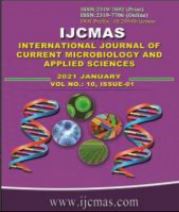


 National Academy of Agricultural Sciences (NAAS)
National Academy of Agricultural Sciences (NAAS)

|
PRINT ISSN : 2319-7692
Online ISSN : 2319-7706 Issues : 12 per year Publisher : Excellent Publishers Email : editorijcmas@gmail.com / submit@ijcmas.com Editor-in-chief: Dr.M.Prakash Index Copernicus ICV 2018: 95.39 NAAS RATING 2020: 5.38 |
Biopesticides serve as second-hand biocontrol agents against harmful microbial growth and supplement as organic pesticides in several agricultural systems. In the production of alternative controls for synthetic insecticides to kill insect pests, biotechnology may also condone them. Bacterial and fungal agents such as Ampelomyces quisqualis and Trichoderma spp., (a control agent for grape powdery mildew) and Bacillus subtilis (used to control plant pathogens) are continually used as second-hand biopesticides. Agile properties of these biocontrol agents either directly affect the pathogen (e.g., Contans) or create a regulated compound during fermentation (e.g., Sonata). The rationale for invariable take-away meals has led traditional agriculture to be heavily dependent on chemicals. Extending the bond between the clientele and the charge on board has driven farmers to pursue new environmentally sustainable approaches to supplement, or at least complement, existing chemical-based activities. The interest in biopesticides has arisen as a potential alternative to traditional pesticides. The effectiveness of biopesticide bacteria such as, Pseudomonas aureofaciens, Bacillus circulans, Agrobacterium radiobacter, B. pumilus and fungi such as Fusarium oxysporum, Ampelomyces quisqualis, Gliocladium virens, Pythium oligandrum and T. harzianum has been used by several countries for sustainable enhancement of crop yield.
 |
 |
 |
 |
 |